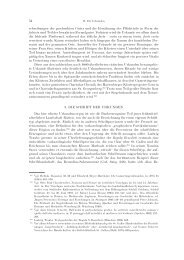Chapter Three ANTHOLOGIES AND ANTHOLOGISTS Between c ...
Chapter Three ANTHOLOGIES AND ANTHOLOGISTS Between c ...
Chapter Three ANTHOLOGIES AND ANTHOLOGISTS Between c ...
You also want an ePaper? Increase the reach of your titles
YUMPU automatically turns print PDFs into web optimized ePapers that Google loves.
110<br />
Part One: Texts and Contexts<br />
Çhsqa, 4nax nek1dzn \Aúdzneáß / oÊpot\ Çtlh me¦nai, peò Í polá ó6rtatoß Ísqa (vv.<br />
43–44). The words of the two sisters of Lazarus, Maria and Martha, are highly<br />
emotional in the biblical version, but are devoid of any concrete meaning in<br />
Kometas’ poem, and thus the deeply felt sorrow of bereavement evaporates<br />
into thin air. This is in general Kometas’ problem: he keeps heaping up magniloquent<br />
words, but none of these words signify anything else than a painful<br />
dearth of feeling. His poem is simply a bad poem, the product of a frigid muse.<br />
However, since it is certainly not the only bad poem written in Byzantium, one<br />
may wonder why Constantine the Rhodian reacted as he did. I think that his<br />
reaction is one of sincere disappointment. The story of Lazarus is fundamental<br />
to Christianity, for it epitomizes one of the quintessential tenets of Christian<br />
faith, namely the resurrection of the dead. It is the prelude to the Anastasis of<br />
Christ. Death is defeated, eternal life is near at hand. With all its theological<br />
connotations, the Raising of Lazarus is a story of hope and happy expectations<br />
– a moment of intense joy relived each year on the last Saturday before Easter.<br />
By turning the story into a sterile exercise in the art of rhetoric, Kometas failed<br />
to convey the message of this liturgical feast to his Byzantine audience.<br />
The poem next in line is AP XV, 28 by Anastasios Quaestor, also known as<br />
the “Stammerer” (Ö traylöß) 85 . Anastasios was born in the later ninth century<br />
and died after 922; he was a close friend of Leo Choirosphaktes and an adversary<br />
of Arethas; he took part in the Doukas revolt (913), was imprisoned in the<br />
Stoudios monastery and regained his former position when Romanos Lekapenos<br />
assumed power (919). Anastasios wrote an encomiastic epitaph on<br />
Metrophanes of Smyrna and a satirical poem on the death of Emperor Alexander.<br />
He is also the author of various iambic canons in the classicistic style of Ps.<br />
John of Damascus 86 . AP XV, 28 describes the scene of the Crucifixion: Christ<br />
on the cross with the two thieves on either side, the Virgin Mary and John the<br />
Apostle, some wayfarers who make fun of Christ, and “the people of the Jews”<br />
offering Him sour wine to drink. The poet depicts the whole scene with short,<br />
vivid brushstrokes, painting as it were in words, and guides our mind’s eye by<br />
presenting the participants and their reactions one after the other in a narrative<br />
sequence. In the first verses he uses descriptive imperfects, but when he<br />
portrays “the wicked and bloodthirsty people of the Jews”, he suddenly uses<br />
an aorist, Ërexe pot‰ta, and thus draws attention to their lewd action. He ends<br />
his description by saying that Christ, who is both Man and God, “was silent<br />
and resisted not”. The poem might well have ended here, but we find to our<br />
surprise three additional verses prescribing the appropriate viewer’s response<br />
to the scene: “Who would be so stupid as to be full of pride when he reflects on<br />
85 On the tumultuous life of the author, see LAUXTERMANN 1998a: 401–405.<br />
86 Ed. PAPADOPOULOS-KERAMEUS 1900: 43–59.




